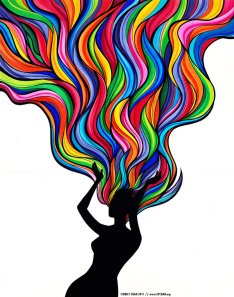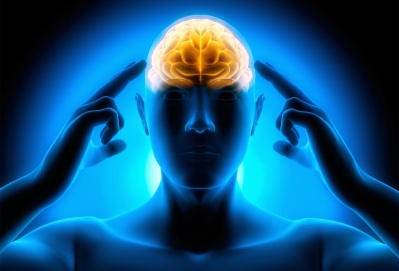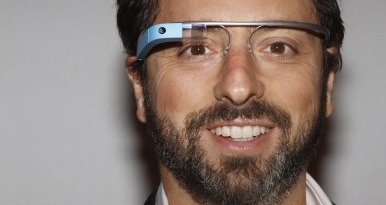The Power of Vision

Synesthesia is a condition in which stimulation of one sensory or cognitive pathway leads to automatic, involuntary experiences in a second sensory or cognitive pathway.
Synesthesia is the phenomena by which people can feel, taste, and hear color. It is a process that happens in the brain that mixes sensory channels, allowing people to experience reality with atypical senses. For example, synesthetes might see red when they feel pain, or see blue when feeling sad. Words, emotions and other concepts are experienced with multiple senses and cannot be fully understood by a single sense [1].
The fact that humans see differently has far-reaching consequences because of the power that vision holds in human society. For example, in court, eyewitness testimony and video evidence are both considered direct evidence, which is more valuable than circumstantial evidence. Seeing an event alone gives your memory more weight in a court of law and a higher chance for conviction or liability [2]. This attests to the idea that seeing is believing which is the main reason why it is crucial to consider the ways that people see differently both literally and conceptually. If ten people see a color and they all say it is red, how do we know that everyone is seeing the same color? In this way, it also calls into question how much people see the same.
Blindness and mental imagery
The definition of “see” is to perceive with the eyes. The secondary definition is to discern or deduce mentally after reflection or from information [3]. I want to focus on the second definition to examine the literal ways in which humans see things differently from one another. The secondary definition also makes a connection to synesthesia because it takes into consideration that the eyes are not exclusively involved in seeing. Vision is much more of a mental process and the eyes are the instruments through which most people perceive and understand the world. However, it is not the only way. For instance, in many cases, “the non-visual images of blind people tend to be clearer than those of sighted people [4].” This means that despite a lack of vision, blind people are able to construct mental imagery based on the perception from their other senses. A study showed that sighted people were better able to mentally picture concrete words such as “cat” or “palm tree,” while blind people were better able to mentally picture more abstract words like “danger.” The definition of “see” is vital to understanding that blindness does not constitute a lack of vision, but rather, it is a different seeing experience than that of sighted people.
Color blindness is a similar example of an alternative way that people mentally discern reality than the majority of the population. There are nearly 3 million cases of color blindness in the United States each year, affecting more men than women [5]. Since color blindness is such a common condition, it calls into question whether there is an absolute truth, or a “correct” way, to perceive reality. The condition of color blindness has been deemed a disability, however other researchers claim otherwise [6]. A recent internet sensation was caused overnight by inconsistencies in one’s perceived color of a dress – was it blue and black or was it gold and white?
Some people saw white and gold, while others saw black and blue. The explanation actually has nothing to do with colorblindness at all, but the way the human eye has evolved. Our eyes have become accustomed to looking at things in the daylight, but daylight does not always give off the same color. The article states that given the context, in this case the picture’s background color, the dress, can cause your brain to allow you to see the wrong color. Half the social media world saw one thing, and the other half saw something completely different. While it may not have been impossible for this to happen in the pre-digital age, it surely wouldn’t have garnered so much attention and debate the way that it did through social media. Technology is not only changing the rate at which we can send and receive media, it is also changing the ways we consume it, and therefore changing the way we see and understand the world.
Seeing Differently with Technology
This TED Talk video with Neil Harbisson connects the ideas of colorblindness, mental imagery and technology. It is a prime example of how people see using senses other than vision. Seeing color is essential to navigating through life. Color gives objects meaning and context. Traffic lights operate solely on color and regarding traffic, green means go and red means stop universally. Colors also give clues about how to interact with certain objects. A red stove would indicate extreme heat, while red skin would likely be painful if touched. Color is such an important part of life that Neil Harbisson installed a chip in the back of his head to be able to experience it.
The chip however allows him to see mental images of color based on sounds rather than allowing him to see color with his eyes. Each sound is prescribed a specific hue that Harbisson has memorized. The technology that he has allows him to visualize colors that the human eye alone cannot see, such as UV rays and infrared rays. What implications does this have about the future of seeing? To what extent will technology continue to alter the way we understand out surroundings?
In order to address the ways that technology is changing the way we see, we can examine some of the changes that have already occurred. Television is still the number one way that people consume the news, but newspaper readership has been on a sharp decline. News is slowly infiltrating more social media applications that were not created with the specific intent to disseminate news. News companies are now competing with Google and Facebook, as people are increasingly getting news from these websites rather than legacy newspapers that have shifted to have an online presence. People can even use Snapchat to get news updates of they so choose.
The content of media cannot be detached from the medium by which it is communicated. There are clear differences in the rapidness and ease of access to online information compared to a newspaper. Virtual media inherently causes the user to interact differently with what they see. Clicking, tapping, listening, nearly instantaneous social reactions have created a much more interconnected sensory experience with what we see on mobile devices. Technology has caused our generation to collectively see things differently than ever before before.
Conceptually Seeing Differently
Given all of the literal ways that people can see differently, I think it is important to understand a conceptual way that our mental interpretations differ. One major conceptual way that people see differently relates to seeing the world through a creative lens.
The technological advancements that have changed the way we see things could only come from innovation, thinking outside of the box and implementing ideas into practice. Rapid advances in technology influence the creative lens of journalists. Recently I interviewed the marketing strategist for a small online magazine. He shared his concerns about the business side of journalism. Many students in my class did similar interviews and yielded responses about fear and worry. M.F. Harmon, from eSchoolNews.com, was optimistic about the future of journalism.
“You just need to stay ahead of the curve and listen to how the audience wants information. The world craves content and its up to the media companies to find the best way to disseminate the information and remain profitable. There’s never been a better time to be a journalist. I think the potential is enormous. I truly believe this generation is going to build something very exciting.”
For students and non-students, it is important to understand that seeing differently relates to bias, objectivity and truth seeking. Our bias allows us to be creative, and will allow media companies to capitalize on the ways that people see differently.
Related Topics
- Blindness
- Seeing Color
- Seeing Change
- Tech & Data
Works Cited
- Than, K. (2005, February 22). Rare but Real: People Who Feel, Taste and Hear Color. Retrieved March 24, 2015, from http://www.livescience.com/169-rare-real-people-feel-taste-hear-color.html
- Direct Evidence. (n.d.). Retrieved March 24, 2015, from http://legaldictionary.thefreedictionary.com/direct Evidence
- See. (2002, January 1). Retrieved March 24, 2015, from http://dictionary.reference.com/browse/see
- Campos, A. (2004). The Vividness of Imagery in a Person Who Has Been Blind for Three Years. Journal Of Visual Impairment & Blindness, 98(5), 309-313.
- Color Blindness. (n.d.). Retrieved March 24, 2015, from http://www.ncbi.nlm.nih.gov/pubmedhealth/PMHT0024265/)
- Capstone Project Poster Presentation, University of Nebraska-Lincoln, Spring 2014
- Sherman, T. (2014) MF Harmon Interview, University of Maryland – College Park, Fall 2014
Additional Resources
1. Deloria, V. (1974). Behind the Trail of Broken Treaties; an Indian declaration of independence. New York: Delacorte Press.
The museum visit had an exhibit that showed records of treaties made between the Indians and Americans. This book analyzes the history of treaty relations in the United States. This related to my topic of seeing differently because there were numerous disagreements when the colonizers arrived from Europe. It is a good background to have regarding the political differences that exist today.
2. Josephy, A. (2006). Lewis and Clark through Indian eyes. New York: Knopf.
This book relates to seeing differently because it examines the positive and negative impacts Lewis and Clark’s journey may or may not have had on Native Americans. This book compares accounts of stories passed down from Clark himself, as well as accounts of the expedition that were passed down to herself, it may serve as a compelling comparison of stories that are a large part of American History.
3. Smith, P. (2009). Everything you know about Indians is wrong. Minneapolis: University of Minnesota Press.
This book is a more comedic take on the issues of stereotypes that damage Indian culture. This is related to my topic and trip to the museum because of the section that talked about the tens of thousands of Indians who live among us in addition to those who live separate from our day-to-day lives. The author is currently the curator at the National Museum of the American Indian and this book is a collection of 17 years of gathered information. It observes the ways that Indians have changed over the past few decades.
4. Berkhofer, R. F. (1978). The white man’s Indian: Images of the American Indian from Columbus to the present. New York: Knopf.
This journal relates to an exhibit at the museum that examines the ways that Americans and Indians see identity differently. It is a reinterpretation of the past that examines stereotypes that Europeans and white Americans have conceived about “Indians,” similar to the book by Smith referenced above.
5. Brode, D. (2005). Multiculturalism and the Mouse: Race and sex in Disney entertainment. Austin: University of Texas Press.
This book discusses the entire entertainment aspect of Disney and the messages is sends regarding the sexual revolution, feminism, subverting the Victorian Ideal, and the gay experience. This relates to my topic because it involves seeing a media company in a different light, and addresses these issues that are related in ways to other articles I have cited, because one chapter is specifically entitled, “Together in perfect harmony:” which analyzes Disney and the Native American experience.
6. Fox, M. T., Nicholas, S. E., & Nelson, C. E. (2003). The American Indian Perspective in America’s History: Resource Guide. Tribal College Journal, 14(3), 30-33.
This journal attempts to clear up the misconceptions that many students may have been taught about Native Americans. It focuses on the other side of the story by examining personal insights of tribal people at various points in American history. It suggests reading “The White Man’s Indian,” which I have referenced above to understand the premises behind white interpretations of Native American history at particular times.
7. Minneapolis Regional Native American Center., & Minneapolis American Indian Center. (1970). The circle: News from an American Indian perspective. Minneapolis, Minn: Minneapolis Regional Native American Center.
This is an example that relates directly to journalism students, challenging them to see the news differently. It relates to an assignment that asks students to see the ways the news is covered differently in terms of format, content, and tone.
Photo Credits
- Different dresses? http://www.wired.com/2015/02/science-one-agrees-color-dress/
- Rainbow visions http://silentreaper.deviantart.com/art/Synesthesia-273485854
- Mental imagery http://www.ontarioselfdefence.ca/mental-imagery-in-the-martial-arts/
- Google glass http://glass-apps.org/google-glass
- Different Faces http://www.huffingtonpost.ca/tamilculture/tamil-filipino_b_6915576.html


